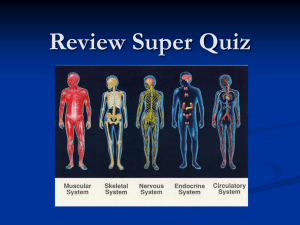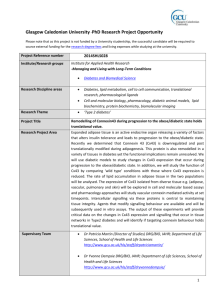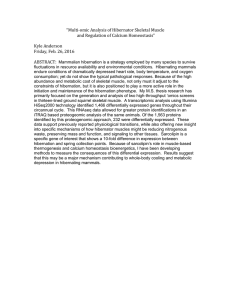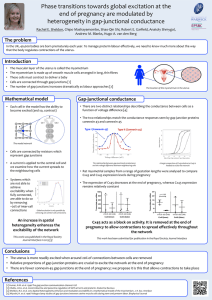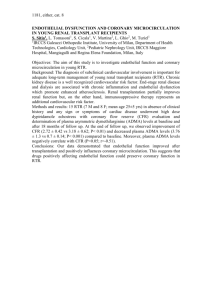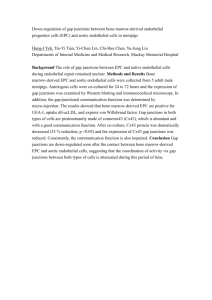Saitongdee,P., Becker,D.L., Milner,P., Knight,G. and
advertisement
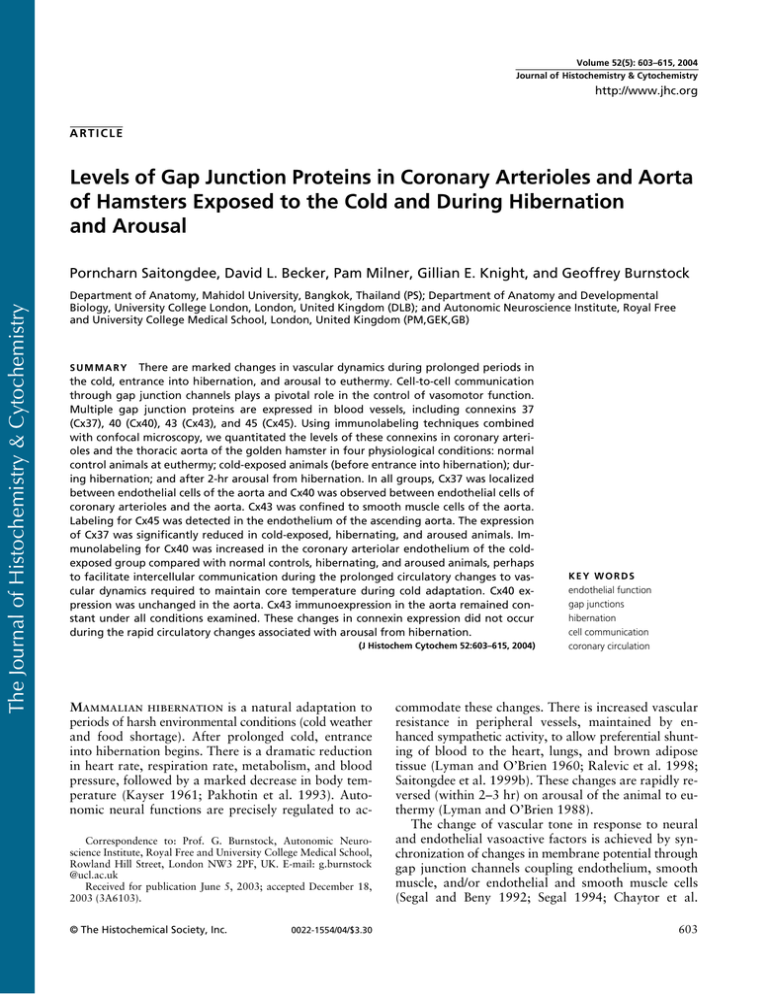
Volume 52(5): 603–615, 2004 Journal of Histochemistry & Cytochemistry http://www.jhc.org ARTICLE Levels of Gap Junction Proteins in Coronary Arterioles and Aorta of Hamsters Exposed to the Cold and During Hibernation and Arousal The Journal of Histochemistry & Cytochemistry Porncharn Saitongdee, David L. Becker, Pam Milner, Gillian E. Knight, and Geoffrey Burnstock Department of Anatomy, Mahidol University, Bangkok, Thailand (PS); Department of Anatomy and Developmental Biology, University College London, London, United Kingdom (DLB); and Autonomic Neuroscience Institute, Royal Free and University College Medical School, London, United Kingdom (PM,GEK,GB) There are marked changes in vascular dynamics during prolonged periods in the cold, entrance into hibernation, and arousal to euthermy. Cell-to-cell communication through gap junction channels plays a pivotal role in the control of vasomotor function. Multiple gap junction proteins are expressed in blood vessels, including connexins 37 (Cx37), 40 (Cx40), 43 (Cx43), and 45 (Cx45). Using immunolabeling techniques combined with confocal microscopy, we quantitated the levels of these connexins in coronary arterioles and the thoracic aorta of the golden hamster in four physiological conditions: normal control animals at euthermy; cold-exposed animals (before entrance into hibernation); during hibernation; and after 2-hr arousal from hibernation. In all groups, Cx37 was localized between endothelial cells of the aorta and Cx40 was observed between endothelial cells of coronary arterioles and the aorta. Cx43 was confined to smooth muscle cells of the aorta. Labeling for Cx45 was detected in the endothelium of the ascending aorta. The expression of Cx37 was significantly reduced in cold-exposed, hibernating, and aroused animals. Immunolabeling for Cx40 was increased in the coronary arteriolar endothelium of the coldexposed group compared with normal controls, hibernating, and aroused animals, perhaps to facilitate intercellular communication during the prolonged circulatory changes to vascular dynamics required to maintain core temperature during cold adaptation. Cx40 expression was unchanged in the aorta. Cx43 immunoexpression in the aorta remained constant under all conditions examined. These changes in connexin expression did not occur during the rapid circulatory changes associated with arousal from hibernation. SUMMARY (J Histochem Cytochem 52:603–615, 2004) Mammalian hibernation is a natural adaptation to periods of harsh environmental conditions (cold weather and food shortage). After prolonged cold, entrance into hibernation begins. There is a dramatic reduction in heart rate, respiration rate, metabolism, and blood pressure, followed by a marked decrease in body temperature (Kayser 1961; Pakhotin et al. 1993). Autonomic neural functions are precisely regulated to acCorrespondence to: Prof. G. Burnstock, Autonomic Neuroscience Institute, Royal Free and University College Medical School, Rowland Hill Street, London NW3 2PF, UK. E-mail: g.burnstock @ucl.ac.uk Received for publication June 5, 2003; accepted December 18, 2003 (3A6103). © The Histochemical Society, Inc. 0022-1554/04/$3.30 KEY WORDS endothelial function gap junctions hibernation cell communication coronary circulation commodate these changes. There is increased vascular resistance in peripheral vessels, maintained by enhanced sympathetic activity, to allow preferential shunting of blood to the heart, lungs, and brown adipose tissue (Lyman and O’Brien 1960; Ralevic et al. 1998; Saitongdee et al. 1999b). These changes are rapidly reversed (within 2–3 hr) on arousal of the animal to euthermy (Lyman and O’Brien 1988). The change of vascular tone in response to neural and endothelial vasoactive factors is achieved by synchronization of changes in membrane potential through gap junction channels coupling endothelium, smooth muscle, and/or endothelial and smooth muscle cells (Segal and Beny 1992; Segal 1994; Chaytor et al. 603 The Journal of Histochemistry & Cytochemistry 604 1998). Gap junction channels have been shown between endothelial cells (Larson and Sheridan 1982), between smooth muscle cells (Uehara and Burnstock 1970), and between smooth muscle and endothelial cells (Spagnoli et al. 1982). Gap junctions are intercellular channels connecting the cytoplasmic compartments of adjacent cells that permit direct exchange of ions and small molecules between cells (Kumar 1999; Willecke et al. 2002). Each cell of adjacent pairs contributes one hemichannel (connexon), which is composed of six protein subunits called connexins (a multigene family of proteins). The sequencing of the human genome has identified 20 human connexins, which thus far have 19 murine homologues (Willecke et al. 2002). Although there are variations in the reported connexin detection patterns between different animal species and vessel types, Cx37, Cx40, and Cx43 remain the major gap junction proteins expressed in blood vessels. There is a recent report of Cx45 expression in smooth muscle cells of rat aorta (Ko et al. 2001). Previous reports have demonstrated that Cx37, localized in the aorta, pulmonary, and coronary arteries, is restricted to the endothelium (Yeh et al. 1997,1998; Gabriels and Paul 1998; Ko et al. 1999; Severs 1999; van Kempen and Jongsma 1999). Cx40 (and the chick equivalent Cx42) has been observed between endothelial cells in large arteries and microvessels (Bruzzone et al. 1993; Gourdie et al. 1993; Little et al. 1995; Yeh et al. 1997,1998; Gabriels and Paul 1998; Ko et al. 1999; Severs 1999; van Kempen and Jongsma 1999) and smooth muscle cells of resistance arterioles, coronary arteries, and aorta (Little et al. 1995; van Kempen and Jongsma 1999). In addition, Cx43 has been detected in the endothelium and/or smooth muscle of various arteries (Bruzzone et al. 1993; Gourdie et al. 1993; Little et al. 1995; Yeh et al. 1997,1998; Hong and Hill 1998; Severs 1999; van Kempen and Jongsma 1999). There is an increase in Cx43 gap junction protein expression in ventricular cardiomyocytes of coldexposed and hibernating hamsters (Saitongdee et al. 2000). In view of the marked changes in vascular dynamics during cold exposure, hibernation, and arousal, in this study we investigated whether there are changes in gap junction expression in the vasculature under these physiological conditions. We examined the expression of Cx37, Cx40, Cx43, and Cx45 in the coronary arterioles (terminal branches of arterial tree) and aorta (a major distribution vessel) in hamsters during hibernation and after 2-hr arousal from hibernation compared to cold-exposed control (cold control) and normal control animals. The expression of gap junction proteins was determined by indirect immunofluorescence techniques combined with quantitative laser scanning confocal microscopy. Saitongdee, Becker, Milner, Knight, Burnstock Materials and Methods Animals We used adult male golden hamsters (Mesocricetus auratus) aged 12 weeks and weighing 140–150 g. Breeding, maintenance, and sacrifice of the animals used in this study followed principles of good laboratory animal care and experimentation in compliance with the UK Animals (Scientific Procedures) Act, 1986. Hamsters were induced to hibernate in the laboratory by shortening the photoperiod and reducing the external ambient temperature, as previously described (Saitongdee et al. 1999a). Hamsters were allowed to hibernate for 8 weeks. During this time they entered bouts of hibernation, lasting about 3–4 days, with alternate periods of wakefulness, lasting 1–2 days. Hibernating animals were sacrificed after a minimum of 3 days into a hibernation bout, while still in deep hibernation. Even when maintained in conditions that induce hibernation, not all hamsters enter hibernation. Hamsters that did not hibernate under these conditions were used as cold control animals. These are well-matched controls because they were maintained under exactly the same conditions of daylight hours, temperature, and nourishment as those that hibernated. A group of hibernating hamsters were aroused from hibernation by being transferred to room temperature (22C) in daylight for 2 hr. Age-matched hamsters that had not been induced to hibernate were used as normal control animals. All experimental animals were weighed, and cheek pouch and rectal temperatures were measured. Tissue Preparation Six hamsters from each of the four experimental groups (normal controls, cold controls, hibernating, and aroused) were sacrificed by CO2 asphyxiation and death was confirmed by cervical dislocation according to Home Office (UK) regulations covering Schedule 1 procedures. The left ventricle, thoracic aorta, and ascending aorta were quickly dissected out. The outer wall of the left ventricle was separated from the aorta; the thoracic and ascending aortas were separated and orientated for transverse sectioning, embedded in OCT, precooled in isopentane, then frozen in liquid nitrogen until sectioning. Cryosections were cut at a thickness of 10 m (Reichert cryostat) and mounted on albumincoated slides. Antibodies The immunolabeling procedures for quantitative assessment of connexin expression used polyclonal antibodies against Cx37, Cx40, Cx43 and Cx45. The details of the antibodies against the four connexins are shown in Table 1. To confirm the distribution of labeling, normal control hamster vessels were immunostained using another antibody to Cx40 raised in guinea pig (see Table 1) and two additional antibodies to Cx43 from different sources [Gap15 (rabbit) and Gap1A (mouse monoclonal)] (see Table 1). Normal rat (Sprague–Dawley, male 250 g) left ventricle and thoracic aorta were also processed alongside these hamster tissues. 605 Gap Junctions in Vessels of Hibernating Hamster Table 1 Details of connexin antibodies Connexin Cx37 Cx40 The Journal of Histochemistry & Cytochemistry Cx43 Cx45 Residues Antiserum Y16Y/R4 against synthetic peptide corresponding to residues 266–281 of cytoplasmic C-terminal of rat Cx37 Peptide corresponding to residues 254–268 of cytoplasmic C-terminal of rat Cx40 Peptide corresponding to residues 256–270 of cytoplasmic C-terminal of rat Cx40 Segment of third cytoplasmic domain of rat Cx43 Peptide corresponding to residues 131–142 of cytoplasmic C-terminal of rat Cx43 Peptide corresponding to residues 131–142 of cytoplasmic C-terminal of rat Cx43 Peptide corresponding to residues 354–367 of cytoplasmic C-terminal of human Cx45 Immunolabeling To detect gap junction proteins, indirect immunofluorescence was performed on cryosections of left ventricle and aorta according to the protocol described by Saitongdee et al. (2000). In brief, tissue sections were fixed in acetone for 7–10 min, then blocked with PBS containing 0.1 M l-lysine, 0.01% bovine serum albumin (BSA), and 0.1% Triton X-100 (diluting medium) for 30 min. The sections then were incubated with the connexin antibodies prepared in diluting medium (anti-Cx37 or -Cx45 at dilutions of 1:50 or 1:100, respectively, overnight; anti-Cx40 or -Cx43 at dilutions of 1:500 or 1:800, respectively, for 1 hr). After washing in PBS, the sections labeled with rabbit antibodies were incubated in biotinylated anti-rabbit IgG (Amersham Biosciences; Poole, UK) diluted 1:200 in buffer for 30 min. After rinsing in PBS they were incubated in 1:200 streptavidin–FITC (Amersham) for 30 min. The sections were rinsed in PBS and mounted with Citifluor (Citifluor; London, UK). For the sections incubated in guinea pig antibodies, the second antibody detection systems used were goat anti-guinea pig immunoglobulins conjugated to FITC (Sigma–Aldrich, Poole, UK; dilution 1:100 for 1 hr). For immunostaining controls, the same procedure was followed with substitution of the primary antibody with either dilution buffer, non-immune serum (Nordic Immunological Laboratories; Tilburg, The Netherlands), or anti-Cx43 preabsorbed with Cx43 peptide (10 g/ml for use with 1 g/ml of primary antibody). To verify the orientation of the sections and show that the endothelium was intact, extra slides (not used in the analysis) were treated with the nuclear stain propidium iodide (1 g/ ml) in the last wash. To confirm the labeling of Cx45 antibody, we used cryosections of ascending aorta as positive controls (Ko et al. 2001). Immunostained sections were examined blind on a Leica TCS 4D confocal microscope (Leica Microsystems; Milton Keynes, UK) immediately after immunostaining. Optical images were stored digitally for subsequent analysis. To confirm the total labeling pattern of each connexin, we used a whole-mount immunostaining technique. Freshly dissected aortas were collected in Hank’s buffered saline so- Dilution Animal antibody raised in Reference/Supplier 1:50 1:100 Rabbit Yeh et al. 1998, kindly provided by Prof. N. Severs 1:500 1:800 Rabbit Guinea pig (Gap 17) Yeh et al. 1997, kindly provided by Dr. R.G. Gourdie Yeh et al. 1998 Rabbit Zymed (San Francisco, CA) Rabbit (Gap 15) Becker and Davies, 1995 Mouse (Gap 1A) Wright et al. 2001 Guinea pig Coppen et al. 1998, kindly provided by Prof. N. Severs 1:500 1:800 1:50 1:100 lution (HBSS) and then cut into small rings before processing for immunofluorescence as for the cryosections. In the last step, the rings of aorta were carefully cut and spread on the slide, endothelial layer face up, then mounted with Citifluor. To confirm the labeling of connexin antibody in gap junctions, we used immunoelectron microscopy. The perfusion-fixed specimens (for 10 min) were continuously immersed in the same fixative (2% paraformaldehyde) for 30 min, then washed three times in PBS. The fixed specimens were dehydrated in 50% methanol for 15 min, followed by 70% and 90% methanol for 45 min each. Infiltration with LR Gold (Agar Scientific; Stansted, UK) was carried out using a 1:1 dilution of resin and then pure resin twice for 30 min, 1 hr, and overnight, respectively. The specimens were embedded in fresh LR Gold and polymerized with UV light at 20C for 24 hr. Immunogold Labeling Techniques The thin sections were picked up on nickel grids and incubated at room temperature successively in 1% BSA in PBS for 10 min, 1% gelatin in PBS for 10 min, and 0.02 M glycine in PBS for 3 min. Sections were immunolabeled as follows. The sections were incubated in the primary antibody, Cx40 antibody raised in rabbit, at a dilution of 1:100 with 1% BSA–Tris-buffered saline (BSA–TBS) blocking medium overnight at 4C. After washing with TBS, the sections were labeled with goat anti–rabbit–10-nm gold complex (British BioCell International; Cardiff, UK) 1:70 in TBS for 1 hr, then washed with TBS and distilled water. The labeled sections were dried and stained with uranyl acetate and lead citrate for 5 min each. Negative controls included either omission or replacement of the primary antibody with preimmune serum. Quantitation Techniques In each of the four groups, sections of the left ventricle and aorta from six individual animals were used. For each animal, four or five coronary arterioles (diameter 20–100 m) The Journal of Histochemistry & Cytochemistry 606 were selected from ventricular sections and five selected fields of aorta were optically sectioned in five 1-m steps. Sections were scanned under identical parameters of imaging (pinhole), objective, filter, and laser power. Levels of PMT gain and offset were set according to procedures standardized to ensure that the image collected displayed a full range of gray level values from black (0 pixel intensity level) to peak white (255 pixel intensity level) and kept constant. Each image was signal-averaged (line average 8) during acquisition to improve image quality by reducing noise. The entire Z-series was projected as a single composite image by superimposition. Quantification of gap junction plaque expression was performed according to an adaptation of the methods in Gourdie et al. (1991) and Haefliger et al. (1997) as described in detail in Saitongdee et al. (2000). In brief, the final image was thresholded to form a binary image. This image was then analyzed using NIH image software 1.62, which generated information on the size and number of individual gap junction plaques in a given area. Five optical fields for six animals of each group were analyzed. Confocal microscope Z-series of aorta were rotated to obtain optimal cross-sections of the tissue. An area of smooth muscle from the internal to the external elastic lamina was then demarcated digitally for quantitative analysis of connexin staining. Smooth muscle gap junction plaques were analyzed in a number of ways: first, as the total combined gap junction area/1000 m2 (“area density”) and second as the total number of individual plaques/1000 m2 (“numerical density”). In the aortic endothelium, gap junction plaque area densities and numerical densities were determined per length of circumferential lining and expressed per 1000 m2. In the coronary arterioles, however, this was not possible because nuclear staining showed that most sections were tangential. Therefore, it was necessary to demarcate the endothelial cell layer digitally for quantitative analysis and to express the plaque area and numerical densities per 1000 m2. Statistical Analysis Data are expressed as the mean SEM of six animals in each group. Statistical analyses and tests were carried out using Minitab software (Minitab Inc. and GB-Stat School Pak). Statistical differences among the four groups were determined by analysis of variance (ANOVA) followed by Tukey’s test; p0.05 was considered significant. Results Animals There were six hamsters in each experimental group. Tissues from these animals have been used in a previous report on connexin expression in cardiomyocytes during hibernation (Saitongdee et al. 2000). The body weights (g) of animals from the hibernating (104.1 5.2) and aroused (98.6 2.0) groups were significantly (p0.05) lower than the cold control (136.6 4.6) and normal control (165.4 7.2) groups. The cold control group weighed significantly less (p0.05) than the normal controls. Saitongdee, Becker, Milner, Knight, Burnstock The cheek pouch and rectal temperatures (C) of the hibernating group (9.6 0.5, 9.8 0.5, respectively) were significantly lower (p0.05) than those of normal control (35.1 0.2, 32.2 0.5), cold control (35.0 0.5, 32.1 0.4) and arousal (34.6 0.4, 31.5 0.5) groups, which were not statistically different from each other. Immunostaining for Cx37 There was no positive immunostaining for Cx37 in the coronary arterioles of the four experimental animal groups. In the aorta, positive immunolabeling of Cx37 was observed between endothelial cells in all four groups with no staining in the media, as shown for the normal control hamster seen in Figure 1a. Histograms showing quantification of Cx37 gap junction plaque area, numerical densities, and plaque size in the aortas of the four animal groups are shown in Figures 1b–1d. There was a significant reduction of the Cx37 area density in the cold controls, hibernation, and arousal animal groups compared with the normal controls (p0.05). The Cx37 numerical density and plaque size were significantly reduced in the cold controls compared with the normal controls for numerical density and cold control plus hibernating for the plaque size. There was a trend for the hibernating and aroused to be similarly reduced, although statistical significance was not reached. Immunostaining for Cx40 Positive Cx40 immunolabeling was confined to the endothelium of coronary arterioles, with no staining in the media in all groups examined. Cx40 staining was prominent and appeared as bright fluorescent puncta in the luminal aspect of the coronary arterioles, and was consistently seen as a comb-like pattern along the intercellular membrane of adjacent endothelial cells (Figures 2a–2d). The localization of Cx40 immunostaining on endothelial cells, rather than on smooth muscle cells, was verified by co-labeling with anti-myosin followed by secondary antibodies conjugated to Cy3 (results not shown). The cold control animals (Figure 2b) exhibited consistently higher levels of Cx40 staining compared with the normal control (Figure 2a), hibernating (Figure 2c), and aroused (Figure 2d) animal groups. Although this may not always be immediately obvious to the eye, in the median specimen from each group shown in Figure 2, a clear difference was evident when the signal was quantified in all of the animals. There was also clear labeling of Cx40 in capillaries in the ventricular tissue (Figure 2e) in all animal groups examined; nuclear staining revealed that this was between the endothelial cells. The Journal of Histochemistry & Cytochemistry Gap Junctions in Vessels of Hibernating Hamster 607 There was no fluorescent signal when the primary antibody was substituted with non-immune serum (not shown). Cx40 immunostaining using a different source of antibody (Gap17) showed the same distribution of staining as above, which was similar to that of the rat coronary arteriole. Histograms showing the results of quantification of Cx40 gap junction plaque area, numerical densities, and plaque size in the coronary arterioles of the four animal groups are shown in Figure 3. Cold control animals showed an increase in Cx40 area density compared with the other groups, which was significant compared with levels in the hibernation group (p0.05). There were no significant differences between the normal control, hibernation, and arousal groups. There were no significant differences in the numerical density and plaque size of Cx40 among the four animal groups. In the aorta of the four experimental animal groups, immunostaining for Cx40 was detected in the endothelium. Prominent fluorescent puncta of Cx40 staining were seen evenly distributed in the tunica intima (Figure 2f). Nuclear labeling revealed that this staining was restricted to the luminal monolayer of endothelial cells. Histograms showing the quantitation of Cx40 gap junction plaque expression in endothelial cells of the aorta are shown in Figure 4. There were no significant differences in any parameters of endothelial cell Cx40 staining among the four animal groups. The normal control mean Cx40 plaque size in the aortic endothelium (0.96 0.18 m2) was approximately three times that of the coronary arteriole endothelium (0.30 0.02 m2). Thin sections of LR Gold-embedded aorta revealed endothelium gap junctions formed by the adjacent cell membranes of neighboring cells (Figure 2g). The Cx40 labeling was decorated with gold particles specifically along the junctional membranes, with minimal background labeling elsewhere in the section. Negative controls consistently showed no labeling. Immunostaining for Cx43 In all animal groups there was no positive staining for Cx43 throughout the coronary arteriolar wall. However, in sections of left ventricle supplied by coronary arterioles, Cx43 staining was detected at intercalated disk structures between cardiomyocytes (Figure 5a). Some sections were processed alongside sections of aorta that showed positive staining for Cx43, thus confirming that the lack of detection of these Cxs in coronary arterioles was reliable and not due to procedural factors. In the aortas of the four experimental animal groups, immunostaining for Cx43 was confined to the Figure 1 (a) Projection confocal microscopy constructed from five optical sections of Cx37 immunostaining in transverse sections of hamster thoracic aorta of the normal control. Some small fluorescent puncta are located between neighboring endothelial cells (arrows). Bar 25 m. Histograms showing the results of quantification of Cx37 junction (b) area density, (c) numerical density, and (d) plaque size in aortic endothelial cells. Values were obtained from projection images of five levels in five fields of aorta for each individual animal tissue. Note that gap junction plaque densities were calculated per circumferential length of endothelial cell layer. The data are expressed as mean SEM. n6 for each group. *,**, and *** denote significant difference between groups marked by horizontal bar p0.05. The Journal of Histochemistry & Cytochemistry 608 Saitongdee, Becker, Milner, Knight, Burnstock Figure 2 Laser scanning or projection confocal micrographs constructed from five optical sections showing positive Cx40 immunostaining in hamster left ventricle and thoracic aorta. These examples are the median expression levels from each group. (a–d) Cx40 immunostaining in coronary arterioles of (a) normal control, (b) cold control, (c) hibernating, and (d) aroused hamsters. Abundant fluorescent punctate labeling is seen between the adjacent endothelial cells. Note greater intensity of labeled gap junctions in cold control (b) compared to the other groups (a,c,d). (e) Cx40 immunostaining in normal control hamster left ventricular tissues showing fluorescent punctate labeling confined to the endothelial cells of capillaries (arrows), with no staining of cardiomyocytes. (f) Cx40 immunoreactivity in the thoracic aorta of the normal control. Strikingly fluorescent punctate labeling is located between adjacent endothelial cells (arrows) close to the lumen (Lu). Bar 25 m. (g) Electron micrograph of immunogold labeling for Cx40 in the thoracic aorta showing that the gold markers were localized specifically on the gap junctions between the adjacent endothelial cells. 609 Gap Junctions in Vessels of Hibernating Hamster The Journal of Histochemistry & Cytochemistry smooth muscle cells (Figure 5b), with no labeling in the endothelium. No discernible differences in staining were observed among the four groups of animals. Quantitative measurements of aortic smooth muscle Cx43 plaque area density, numerical density, and size revealed no significant differences among the animal groups, as shown in the histogram (Figure 6). No immunostaining was detected when the primary antibody was substituted by non-immune serum or, in the case of Cx43, with anti-Cx43 preabsorbed Figure 4 Histograms showing the results of quantification of Cx40 gap junctional (a) area density, (b) numerical density, and (c) plaque size in aortic endothelial cells. Values were obtained from projection images of five levels, in five fields of aorta for each individual animal tissue. Note that gap junction plaque densities were calculated per circumferential length of endothelial cell layer. Data are expressed as mean SEM. n6 for each group. with Cx43 peptide (Figure 5c). Cx43 immunostaining using two different sources of antibody (Gap15 and Gap1A) showed the same distribution of staining as above, which was similar to that of the rat coronary arteriole. Immunostaining for Cx45 Figure 3 Histograms showing results of quantitative analysis of Cx40 gap junction (a) area density, (b) numerical density, and (c) plaque size in the coronary arterioles from the four animal groups. Values were obtained from projection images of five levels in five examined arterioles for each individual animal tissue. Data are expressed as mean SEM. n6 for each group. *Denotes significant difference between groups marked by horizontal bar p0.05. There was no positive Cx45 labeling in the coronary vasculature of any of the animal groups. Similarly, there was no positive staining for Cx45 throughout the arterial wall of the thoracic aorta in any of the animal groups. However, in sections of ascending aorta, sparse Cx45 staining was found at the intimal surface of the vessel (Figure 7). 610 Saitongdee, Becker, Milner, Knight, Burnstock Distribution of Whole-mount Immunostaining in Aorta The Journal of Histochemistry & Cytochemistry Small fluorescent puncta of Cx37 staining were detected in adjacent endothelial cells (Figure 8a). In contrast, labeling for Cx40 was abundant, with immunofluorescent puncta noted between endothelial cells (Figure 8b), the fluorescent spots defining the border of individual endothelial cells. Cx43 labeling was seen as tiny fluorescent spots between the smooth muscle cells (Figure 8c). Cx45-positive labeling in the hamster ascending aorta was very sparse and was associated with neighboring endothelial cells (Figure 8d) and smooth muscle cells (Figure 8e). Discussion In hamster coronary arterioles and aorta, gap junction proteins were seen by immunofluorescence staining as fluorescent puncta between endothelial cells and/or smooth muscle cells, as previously described in the rat and rabbit (Bruzzone et al. 1993; Carter et al. 1996; Gros and Jongsma 1996; Haefliger et al. 1997; Yeh et al. 1997; Hong and Hill 1998; van Kempen and Jongsma 1999; Ko et al. 2001). Using selective antibodies to Cx37, Cx40, Cx43, and Cx45, we found a consistent localization of Cx37 in hamster aortic endothelial cells, Cx40 in coronary arteriole and aortic endothelium, and Cx43 in smooth muscle cells of the aorta, whereas there was no positive staining for Cx45 in either coronary arterioles or thoracic aorta from any of the experimental groups. With these same antibodies, the distribution of staining was similar to that in the rat. The Cx37 labeling was distinct between endothelial cells of the aorta but not in coronary arterioles, a finding in agreement with previous reports in the rat (Yeh et al. 1997,1998; van Kempen and Jongsma 1999). However, Cx37 immunoreactivity has been reported in endothelial and smooth muscle cells of rat coronary artery and cheek pouch arterioles of the hamster (Little et al. 1995; van Kempen and Jongsma 1999). Cx40 expression in endothelial cells of coronary arterioles and aorta is consistent with previous reports (Bruzzone et al. 1993; Yeh et al. 1997,1998; Gabriels and Paul 1998; van Kempen and Jongsma 1999). Figure 5 Laser scanning or projection confocal microscopy constructed from five optical sections of Cx43 immunostaining in transverse sections of hamster left ventricle and thoracic aorta of the normal control. (a) Cx43 immunostaining of left ventricle confined to the intercalated disks between ventricular cardiomyocytes but no staining in a coronary arteriole (CA). (b) Cx43 immunostaining of the thoracic aorta. Discrete gap junctions are scattered throughout the smooth muscle wall. (c) Control staining of the aorta using non-immune serum. Bar 25 m. The Journal of Histochemistry & Cytochemistry Gap Junctions in Vessels of Hibernating Hamster 611 Figure 7 Cx45 immunostaining in the ascending aorta; very little labeling was detected at the endothelium (arrows). To enable optimal Cx45 immunostaining, glutaraldehyde was omitted from the fixation process. Therefore, ultrastructural integrity was not maintained at the normal standard for an electron micrograph. This was unavoidable. Bar 25 m. Figure 6 Histograms showing the results of quantification of Cx43 gap junctional (a) area density, (b) numerical density, (c) plaque size in aortic smooth muscle cells. Values were obtained from projection images of five levels in five fields of aorta for each individual animal tissue. Note that gap junction plaque densities were calculated per the area of smooth muscle layer. Data are expressed as mean SEM. n6 for each group. Cx43 expression in aortic smooth muscle cells but not endothelium has also been described in the rat (Bruzzone et al. 1993), although others have localized Cx43 in the endothelium but not smooth muscle (Haefliger et al. 1997; Yeh et al. 1997,1998; Hong and Hill 1998; van Kempen and Jongsma 1999). Recently, there has been a report of Cx45 labeling in the smooth muscle layer of many areas of rat aorta (Ko et al. 2001), but in our study the expression of Cx45 was different, in that positive labeling was present in both the smooth muscle and endothelium but only in the ascending part of the aorta. This suggests that connexin expression is species- and site-specific. The main findings of this study are that there are selective changes in endothelial expression of Cx37 in the aorta and Cx40 expression in coronary arterioles among the groups tested. There was a significant decrease in the level of Cx37 in the aortic endothelium of cold-exposed animals, with a trend towards a return to the normal control level after arousal from hibernation. In addition, Cx40 gap junction plaque area in coronary arteriole endothelium of cold-exposed hamsters was increased. During hibernation, the expression of Cx40 gap junction plaques was comparable with that in normal control animals and remained constant during arousal. This finding is remarkable because, during hibernation and arousal from hibernation, there are profound changes in vascular dynamics (Lyman and Chatfield 1955; Lyman 1965). The changes are likely to reflect adaptations in vascular physiology required either to enter a hibernation state or to survive cold exposure. Similarly, the effect on area density is unlikely to reflect contraction of endothelial cells due to cold-induced vasospasm because this effect was not observed in other tissues investigated. We have previously shown that chronic cold exposure induces an increase in Cx43 expression in ventricular cardiomyocytes in the hamster, which is maintained during hibernation and reverts to normal levels on arousal, which may contribute to tolerance to ventricular fibrillation in hibernators as body temperature drops (Saitongdee et al. 2000). Hibernators and non-hibernators respond to cold acclimation in a similar way to maintain core temperature (Pohl and Hart 1965). During chronic cold ex- 612 Saitongdee, Becker, Milner, Knight, Burnstock The Journal of Histochemistry & Cytochemistry Figure 8 Laser scanning confocal micrographs showing nuclei in red with green positive Cx immunostaining in hamster thoracic aorta (a–c) and ascending aorta (d–e) using whole mounts. The labeling of (a) Cx37 is detected as small fluorescent puncta in the endothelial cell layer; (b) Cx40 is defined prominently as abundant puncta in between endothelial cells; (c) Cx43 is present as several tiny spots in the smooth muscle cell layer; (d,e) a few Cx45-positive plaques are seen in endothelial cells (d) and in smooth muscle cells (e) of the hamster ascending aorta. Bar 25 m. 613 The Journal of Histochemistry & Cytochemistry Gap Junctions in Vessels of Hibernating Hamster posure, heart rate and stroke volume increase concomitant with subcutaneous vasoconstriction under sympathetic control (Pohl and Hart 1965). Rats exposed to the cold for several weeks become hypertensive (Fregly et al. 1991; Sun et al. 1997) and in aortic smooth muscle from hypertensive rats, Cx43 expression and plaque size are increased (Berry and Sosa– Melgarejo 1989; Watts and Webb 1996; Haefliger et al. 1997,1999). In the cold, coronary arteriolar vasodilatation ensures adequate nutrient supply to the heart muscle via increased blood flow (Rosaroll et al. 1996). It has been shown that Cx43 mRNA expression is upregulated in rat cultured aortic endothelial cells exposed to laminar shear stress and in smooth muscle cells exposed to stretch (Cowan et al. 1998). The Cx43 expression is localized to sites of turbulent shear stress, whereas Cx37 and Cx40 are distributed uniformly in the aorta (Gabriels and Paul 1998). Shear stress- and stretch-enhanced coupling of cells via gap junctions may amplify signal propagation and influence vasomotor reactivity at sites of increased metabolic activity, i.e., at sites of increased blood flow (Cowan et al. 1998). The prominent Cx40 plaques in all groups examined and the increase in expression in cold-exposed hamsters may reflect the response to increased coronary blood flow and hence increased shear stress at the vessel lumen. Although we cannot comment on the functional integrity of gap junction channels from our studies, increased gap junction plaque formation between endothelial cells may serve to increase the efficiency of interendothelial communication to ensure sustained widespread vasodilatation (Segal and Duling 1986,1989). Increased blood flow stimulates endothelial cells to release vasoactive agents, which can act via nitric oxide (NO) to bring about smooth muscle relaxation and vasodilatation (Milner et al. 1990). There is evidence that NO modulates gap junctional conductance. In interneurons of the retina, NO reduces the overall open probability of gap junctions by activation of guanyl cyclase and protein kinase G (Lu and McMahon 1997). Recent reports have demonstrated that heterocellular gap junctional (myoendothelial) communication contributes to NO- and prostanoid-independent vasorelaxation attributed to endothelium-derived hyperpolarizing factor (Chaytor et al. 1998). Another factor that may lead to an increase in gap junction density during cold exposure is reduced degradation of connexins by proteasomal and lysosomal enzymes. Heat shock proteins are increased in cold stress, and it has been shown that HSP70 protects against connexin degradation (Laing et al. 1998). On entrance into hibernation there was a reversal of the increased Cx40 immunoexpression in coronary arteriole endothelium to normal control levels. On arousal from hibernation there were no significant changes in gap junction protein expression compared to expression during hibernation. In hibernating animals there are several changes in the circulating blood that may influence the endothelium: arterial pH drops from 7.39 to 7.01 due to respiratory acidosis (Malan et al. 1988); plasma glucose levels are reduced (from 142 mg% to 96 mg%) as glucose consumption exceeds glycogenolysis (Galster and Morrison 1970; Atgie et al. 1990); and blood flow is drastically reduced (at least 90%). Because all these factors are reversed on arousal, when gap junction protein levels do not change, it is unlikely that they are involved in the selective reduction of gap junction expression as animals enter hibernation after prolonged periods in the cold. Cx40 gap junctional protein was far more abundant between endothelial cells of the aorta than was Cx37. These two connexins may form heteromeric connexons [Cx37 and Cx40 form one connexon of gap junction hemichannels (Brink et al. 1997)] and/or heterotypic gap junction channel [each connexon of one channel is formed from different connexins (Wolosin et al. 1997)]. In in vitro studies, connexons composed of Cx37 channels form functional channels with both Cx40 channels and Cx43 channels (Elfgang et al. 1995; Brink et al. 1997). Different gap junction connexin proteins are functional during the various phases of the healing process (Yeh et al. 2000). Altered expression of Cx37 occurs in the arterial wall in response to artherogenesis in the dog during hemodynamic changes, including increased shear stress (Cai et al. 2001). Our results showed that, in aortic endothelium, only Cx37 expression was reduced during exposure to the cold. This suggests that regulation of expression of Cx37 may be involved in the modulation of the response of the aorta to altered physiological demands. Cx37 gap junctions in the hamster aorta may be involved in dynamic processes associated with adaptation to the cold. In summary, the increased density of Cx40 gap junctional protein in the endothelial cells of coronary arterioles of cold-exposed animals may reflect increased intercellular communication during prolonged periods of increased blood flow and pressure during cold stress. These changes are reversed during hibernation, when the heart rate and blood flow decrease. Reduced levels of Cx37 gap junctional protein in the hamster aorta during cold exposure may reflect physiological responses in preparation for hibernation. The rapid changes in circulatory dynamics associated with arousal do not appear to involve gap junction protein expression. Acknowledgment We are very grateful to Dr C. Orphanides for excellent editorial assistance. 614 The Journal of Histochemistry & Cytochemistry Literature Cited Atgie C, Nibbelink M, Ambid L (1990) Sympathoadrenal activity and hypoglycemia in the hibernating garden dormouse. Physiol Behav 48:783–787 Becker D, Davies C (1995) Role of gap junctions in the development of the preimplantation mouse embryo. Microsc Res and Tech 31:364–374 Berry L, Sosa–Melgarejo J (1989) Nexus junctions between vascular smooth muscle cells in the media of the thoracic aorta in normal and hypertensive rats: A freeze-fracture study. J Hypertens 7:507–513 Brink PR, Cronin K, Banach K, Peterson E, Westphale EM, Seul KH, Ramanan SV, et al. (1997) Evidence for heteromeric gap junction channels formed from rat connexin43 and human connexin37. Am J Physiol 273:C1386–1396 Bruzzone R, Haefliger J, Gimlich RL, Paul DL (1993) Connexin40, a component of gap junctions in vascular endothelium, is restricted in its ability to interact with other connexins. Mol Biol Cell 4:7–20 Cai WJ, Koltai S, Kocsis E, Scholz D, Schaper W, Schaper J (2001) Connexin37, not Cx40 and Cx43, is induced in vascular smooth muscle cells during coronary arteriogenesis. J Mol Cell Cardiol 33:957–967 Carter T, Chen X, Carlile G, Kalapothakis E, Ogden D, Evans W (1996) Porcine aortic endothelial gap junctions: identification and permeation by caged InsP3. J Cell Sci 109:1765–1773 Chaytor A, Evans W, Griffith T (1998) Central role of heterocellular gap junctional communication in endothelium-dependent relaxations of rabbit arteries. J Physiol (Lond) 508:561–573 Coppen S, Dupont E, Rothery S, Sever N (1998) Connexin45 expression is preferentially associated with the ventricular conduction system in mouse and rat heart. Circ Res 82:232–243 Cowan D, Lye S, Langille B (1998) Regulation of vascular connexin43 gene expression by mechanical loads. Circ Res 82:786–793 Elfgang C, Eckert R, Lichtenberg–Frate H, et al. (1995) Specific permeability and selective formation of gap junction channels in connexin-transfected HeLa cells. J Cell Biol 129:805–817 Fregly M, Shechtman O, van Bergen P, Reeber C, Papanek P (1991) Changes in blood pressure and dipsogenic responsiveness to angiotensin II during chronic exposure of rats to cold. Pharmacol Biochem Behav 38:837–842 Gabriels J, Paul D (1998) Connexin43 is highly localized to sites of disturbed flow in rat aortic endothelium but connexin37 and connexin40 are more uniformly distributed. Circ Res 83:636– 643 Galster W, Morrison P (1970) Cyclic changes in carbohydrate concentrations during hibernation in the arctic ground squirrel. Am J Physiol 218:1228–1232 Gourdie R, Green C, Severs N (1991) Gap junction distribution in adult mammalian myocardium revealed by an anti-peptide antibody and laser scanning confocal microscopy. J Cell Sci 99: 41–55 Gourdie RG, Green CR, Severs NJ, Anderson RH, Thompson RP (1993) Evidence for a distinct gap-junctional phenotype in ventricular conduction tissues of the developing and mature avian heart. Circ Res 72:278–289 Gros DB, Jongsma HJ (1996) Connexins in mammalian heart function. Bioessays 18:719–730 Haefliger J, Castillo E, Waeber G, Bergonzelli G, Aubert J, Sutter E, Nicod P, et al. (1997) Hypertension increases connexin43 in a tissue-specific manner. Circulation 95:1007–1014 Haefliger JA, Meda P, Formenton A, Wiesel P, Zanchi A, Brunner HR, Nicod P, et al. (1999) Aortic connexin43 is decreased during hypertension induced by inhibition of nitric oxide synthase. Arterioscler Thromb Vasc Biol 19:1615–1622 Hong T, Hill C (1998) Restricted expression of the gap junctional protein connexin 43 in the arterial system of the rat. J Anat 192:583–593 Kayser C (1961) The Physiology of Natural Hibernation. New York, Pergamon Press Saitongdee, Becker, Milner, Knight, Burnstock Ko YS, Coppen SR, Dupont E, Rothery S, Severs NJ (2001) Regional differentiation of desmin, connexin43, and connexin45 expression patterns in rat aortic smooth muscle. Arterioscler Thromb Vasc Biol 21:355–364 Ko YS, Yeh HI, Rothery S, Dupont E, Coppen SR, Severs NJ (1999) Connexin make-up of endothelial gap junctions in the rat pulmonary artery as revealed by immunoconfocal microscopy and triple-label immunogold electron microscopy. J Histochem Cytochem 45:683–692 Kumar NM (1999) Molecular biology of the interactions between connexins. Novartis Found Symp 219:6–16; discussion 16–21, 38–43 Laing J, Tadros P, Green K, Saffitz J, Beyer E (1998) Proteolysis of connexin43-containing gap junctions in normal and heatstressed cardiac myocytes. Cardiovasc Res 38:711–718 Larson D, Sheridan J (1982) Intercellular junctions and transfer of small molecules in primary vascular endothelial cultures. J Cell Biol 92:183–191 Little T, Beyer E, Duling B (1995) Connexin 43 and connexin 40 gap junctional proteins are present in arteriolar smooth muscle and endothelium in vivo. Am J Physiol 268:H729–739 Lu C, McMahon D (1997) Modulation of hybrid bass retinal gap junctional channel gating by nitric oxide. J Physiol (Lond) 499:689–699 Lyman CP (1965) Circulation in mammalian hibernation. In Hamilton WF, Dow P, eds. Handbook of Physiology. Circulation. Sect 2, Vol 3. Chapter 56. Washington, American Physiological Society, 1967–1990 Lyman C, O’Brien R (1960) Circulatory changes in the thirteenlined ground squirrel during the hibernating cycle. In Lyman C, Dawe A, eds. Mammalian Hibernation. Bull Mus Comp Zoo, 353–372 Lyman C, O’Brien R (1988) A pharmacological study of hibernation in rodents. Gen Pharmacol 19:565–571 Lyman CP, Chatfield PO (1955) Physiology of hibernation in mammals. Physiol Rev 38:403–425 Malan A, Mioskowski E, Calgari C (1988) Time-course of blood acid-base state during arousal from hibernation in the European hamster. J Comp Physiol [B] 158:495–500 Milner P, Kirkpatrick KA, Ralevic V, Toothill V, Pearson J, Burnstock G (1990) Endothelial cells cultured from human umbilical vein release ATP, substance P and acetylcholine in response to increased flow. Proc R Soc Lond [B] 241:245–248 Pakhotin P, Pakhotina I, Belousou A (1993) The study of brain slices from hibernating mammals in vitro and some approaches to the analysis of hibernation problems in vivo. Prog in Neurobiol 40:123–161 Pohl J, Hart JS (1965) Thermal regulation and cold acclimation in a hibernator, Citellus tridecemlineatus. J Appl Physiol 20:398–404 Ralevic V, Knight G, Burnstock G (1998) Effects of hibernation and arousal from hibernation on mesenteric arterial responses of the golden hamster. J Pharmacol Exp Ther 287:521–526 Rosaroll PM, Venditti P, Meo SD, Leo TD (1996) Effect of cold exposure on electrophysiological properties of rat heart. Experientia 52:577–582 Saitongdee P, Loesch A, Milner P, Knight G, Burnstock G (1999a) Ultrastructural localisation of nitric oxide synthase and endothelin in the renal and mesenteric arteries of the golden hamster: differences during and after arousal from hibernation. Endothelium 6:197–207 Saitongdee P, Milner P, Becker DL, Knight GE, Burnstock G (2000) Increased connexin43 gap junction protein in hamster cardiomyocytes during cold acclimatization and hibernation. Cardiovasc Res 47:108–115 Saitongdee P, Milner P, Loesch A, Knight G, Burnstock G (1999b) Electron-immunocytochemical studies of perivascular nerves of mesenteric and renal arteries of golden hamsters during and after arousal from hibernation. J Anat 195:121–130 Segal SS (1994) Cell-to-cell communication coordinates blood flow control. Hypertension 23:1113–1120 Segal SS, Beny J (1992) Intracellular recording and dye transfer in arterioles during blood flow control. Am J Physiol 263: H1–7 The Journal of Histochemistry & Cytochemistry Gap Junctions in Vessels of Hibernating Hamster Segal SS, Duling B (1986) Flow control among microvessels coordinated by intercellular conduction. Science 234:868–870 Segal SS, Duling B (1989) Conduction of vasomotor responses in arterioles: a role for cell-to-cell coupling? Am J Physiol 256: H838–845 Severs N (1999) Cardiovascular disease. Norvartis Found Symp 219:188–206; discussion 206–211 Spagnoli L, Villaschi S, Neri L, Palmieri G (1982) Gap junctions in myo-endothelial bridges of rabbit carotid arteries. Experientia 38:124–125 Sun Z, Cade J, Fregly M (1997) Cold-induced hypertension. A model of mineralocorticoid-induced hypertension. Ann NY Acad Sci 813:682–688 Uehara Y, Burnstock G (1970) Demonstration of “gap junctions” between smooth muscle cells. J Cell Biol 44:215–217 van Kempen MJ, Jongsma HJ (1999) Distribution of connexin37, connexin40 and connexin43 in the aorta and coronary artery of several mammals. Histochem Cell Biol 112:479–486 Watts S, Webb R (1996) Vascular gap junctional communication is increased in mineralocorticoid-salt hypertension. Hypertension 28:888–893 Willecke K, Eiberger J, Degen J, Eckardt D, Romualdi A, Guldena- 615 gel M, Deutsch U, et al. (2002) Structural and functional diversity of connexin genes in the mouse and human genome. Biol Chem 383:725–737 Wolosin JM, Schutte M, Chen S (1997) Connexin distribution in the rabbit and rat ciliary body. A case for heterotypic epithelial gap junctions. Invest Ophthalmol Vis Sci 38:341–348 Wright CS, Becker DL, Lin JS, Warner AE, Hardy K (2001) Stagespecific and differential expression of gap junctions in the mouse ovary: connexin-specific roles in follicular regulation. Reproduction 121:77–88 Yeh HI, Chang HM, Lu WW, Lee YN, Ko YS, Severs NJ, Tsai CH (2000) Age-related alteration of gap junction distribution and connexin expression in rat aortic endothelium. J Histochem Cytochem 48:1377–1389 Yeh HI, Dupont E, Coppen S, Rothery S, Severs N (1997) Gap junction localization and connexin expression in cytochemically identified endothelial cells of arterial tissue. J Histochem Cytochem 45:539–550 Yeh HI, Rothery S, Dupont E, Coppen S, Severs N (1998) Individual gap junction plaques contain multiple connexins in arterial endothelium. Circ Res 83:1248–1263
